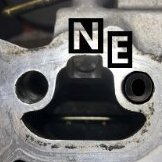Custom Glass Carbon Fibre R33 Projector Headlights Group Buy!
Announcements
-
Similar Content
-
Latest Posts
-
And if you want more power, more reliably, and cheaper, go get the Aussie RB... The 4L Barra and put that in instead.
-
No cats will keep discolouring the rear bar. Sends white paint a weird yellow stain. Cut and polish normally gets it out, but you'll be doing that every fortnight I found.
-
Both heads will be equally reliable or unreliable depending on what you do to them. Stock the RB26 head will flow more. You have access to the stock intake ITB manifold on the RB26 cheaply which flows really well(1000hp+). Arguably more aftermarket support for RB26, though in Aus we love our RB30 SOHC heads too. The only downsides to the RB26 head is if you have a VL commodore and want to keep the SOHC look. Where you may have an issue is drilling out the rb30 block for the bigger head studs but if you are building a big power motor you'd probably put bigger studs on the SOHC head too. This is just about finding a good machine shop, sometimes easier said than done. RB30 head worked can make big power just like a Rb26 head, so really it actually more comes down to what your preference is for your car. People now even making billet versions of both.
-
2630s work perfectly well. There is something to be said for just using the 30 head, as it saves all the pain of the conversion, still makes tons of power, still sounds cool, etc etc. 2630 will obviously make more power again, but the differences are not stupidly big. It really depends on whether you're racing for sheep stations or not. If it's dead serious, then it's a 26 head. If it's just for fun, it could go either way. But the 26 head and the effort to get it set up, etc etc, is part of the fun.
-
By lilley's gtr · Posted
I've been building a 26/30 for a few years now. I've had the head built with all the good stuff. I had a 32 gtr but blew it up and yes its all going into a vl but im looking for some advice from some RB nuts on pros and cons on putting a 26 head on a 30 bottom end is it worth it Works are as follows Head -Extensive porting 1mm oversized supertech valves Supertech double springs Supertech valve guides Supertech titanium retainers Tomei solid lifters Tomei 270 x 10.25 cams Head drain Bottom end series 2 rb30 block Cp ceramic coated pistons Eagle rods Romac balancer Oil restrictions O ringed blah blah spent a fortune And will get a girdle because the 30s arent used to handling that much rpm Nitto billet oil pump Hypertune plenum 6boost mani Refurbed astra pump thats the cover for it in the boot I did have a precision 6262 but sold it because drag car life. Currently building the ass end full 4 link floater rear end with a 2 speed But the dilemma i have is my mate rekens I should just stick with the 30 head for reliability. Has any one had any issues with mounting the 26 head ie compression blowing gaskets etc. Just looking for some advice from people who have gone down this route. Here's some photos. Blew the oil pump in the gtr and decided to rip the motor out at the time and do a full build only to find it had been a repairable write off so went down this path.
-







Recommended Posts